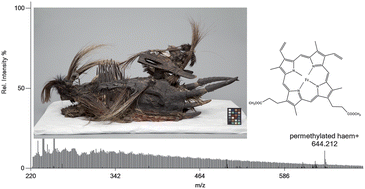
The Detroit Institute of Arts' Komo mask. Image courtesy of the DIA.
Typically dried or degraded blood samples at crime scenes are positively identified via a catalytic reaction with the haem protein, which produces a colored signal or interacts uniquely with light. In addition to blood, other proteins can undergo the same reaction, yielding inaccurate results. This high failure rate makes these tests unreliable and requires further analysis in a laboratory.
Conservators at the Detroit Art Institute in collaboration with chemistry researchers in the US used direct real time mass spectrometry (DART-MS) for the detection of degraded blood samples. This required little sample preparation, when compared to other standard conservation techniques such as HPLC and GC-MS, and identified the haem protein in the coating of an African Komo mask. In addition to cultural artifacts, this methodology can potentially be applied in forensic investigations. The authors detected haem peaks from both myoglobin and haemoglobin quickly and with greater specificity than the simple techniques described previously.
To know more, please access the link below. This paper will be free to read until July 25th.
Characterization of blood in an encrustation on an African mask: spectroscopic and direct analysis in real time mass spectrometric identification of haem
Daniel Fraser, Cathy Selvius DeRoo, Robert B. Cody and Ruth Ann Armitage
Analyst, 2013, Advance Article
DOI: 10.1039/C3AN00633F










